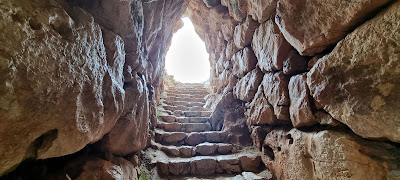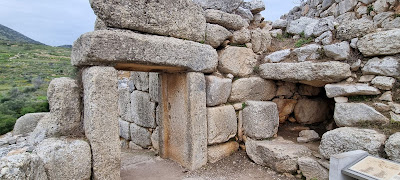24 March 2025 – Mycenae
Miles
driven today = 41
Total Miles
to date = 2,257
Once we had
paid up and said our goodbyes at Camping Nicolas II this morning we backtracked
all the way back to Nafplion. We needed
to stock up on a bit of shopping but we also needed to find a Vodafone shop as
our one month unlimited data deal expired today. We tried to renew it online yesterday but the
website was all in Greek and we got horribly confused so we enlisted the help
of an expert and we are now good for onboard wi-fi until we leave Greece.
Nafplion
was teeming with people. With it being
Greek Independence Day tomorrow everybody was out shopping for supplies for the
celebrations and stages were being set up in town for various events, so we got
out as quickly as we could and headed a few kilometres north to the ancient
ruins of Mycenae.
Mycenae was the centre of the Mycenaean civilization who were a major power in Greece and the Eastern Mediterranean during the latter part of the Bronze Age, between 1750 and 1050 BC.
The City Walls are described as being Cyclopean, which are built using huge, roughly shaped, blocks of rock weighing several tons apiece and which were all somehow hoisted into position using 3,500 year old technology. Mind boggling really.
We entered the city via the Lion Gate, which is described on the information boards as being “the oldest monumental relief in Europe”, dating back to 1240 BC. Unfortunately the lions were decapitated many centuries ago but it’s still an impressive monument.
Just inside the gate is a building called “The Granary”, so called due to the carbonized cereal grains found in its basement. A significant amount of pottery was also found here during excavations.
This is a “Circle Grave”, which was used exclusively for royal burials during the 16th Century BC. It was originally positioned outside the City wall but when the wall was extended in the 13th Century BC it was brought inside.
The “Great Ramp” was built when the citadel was remodelled in the 13th Century BC.
Buildings of the North Quarter with phenomenal views beyond.
The Palace stood at the summit of the hill. There is evidence that there may have been structures here as early as 3,000 BC. Unfortunately most of the Palace had collapsed and is now significantly a reconstruction based on how archeologists assume it would have been laid out. Luckily for us we’ve already seen a better preserved example of a similar building at Nestor’s Palace.
The Artisan’s Quarter formed part of the Palace complex and has been identified as somewhere artists may have worked based on finds of raw materials and unfinished pieces.
Several buildings show evidence of staircases and therefore must have been at least 2 stories high. Most were built in the 13th Century BC and appear to have been destroyed by fire within 100 years of their construction.
The last extension to the city was to the North West in the late 13th Century BC.
This included an underground cistern which stored water supplied via an aqueduct from a spring outside of the city walls.
I clambered down the steps to the point where a locked gate prevents you from falling into the cistern. This is the view looking back up.
The North “Postern” Gate was closed, like the Lion Gate, with a double wooden door and bolted with a sliding bar.
A little way outside the Lion Gate is this Tholos or Beehive Tomb, much like the one we saw close to Nestor’s Palace. This one dates to the early 14th Century BC. The door lintels are just immense.
We had a look in the museum which is full of archeological finds from the site. I had to keep pinching myself that most of these are more than 3,000 years old.
These Figurines were retrieved from one of the Temples.
Spindle whorls used in weaving.
This is a small section of a fresco which is “the largest piece of Mycenaean wall art remaining in situ”.
Various representations of the female form.
A huge stash of grave goods recovered from one of the tombs.
Possessions of a rich Mycenaean lady including bronze mirrors, beads and pendants and a mortar for preparing her cosmetics.
It’s probably worth pointing out at this stage that Lisa doesn’t only come along on these trips to provide a scale for my photography subjects.
Finally we walked a little way down the road to the Tomb of Agamemnon, or the “Treasury of Atreus” as it is otherwise known. It’s another Tholos but this time on a gigantic scale.
We were really lucky. We arrived just as one coach party was leaving and another turned up as we left, so apart from 2 other people we had the place entirely to ourselves.
Inside the acoustics were incredible. A single handclap reverberated for ages and there were also a few bumble bees in there which sounded like a huge swarm. Highly appropriate in a “beehive” tomb.
Back in the van we dropped back down the hill to the modern day town of Mykines. We are in Camping Atreus, one of two campsites in the area. It appears to be in the process of awakening from its winter slumbers but it’s only €20 a night so it’ll suit us just fine for our final night on the Peloponnese.





























Comments
Post a Comment